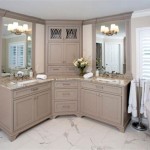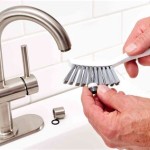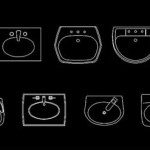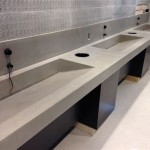Small Bathroom Ideas: Maximizing Space Without a Shower
Small bathrooms present unique design challenges. Often, the focus rests on incorporating a shower or bathtub, leaving little room for other essentials. However, many situations call for a bathroom design that specifically excludes a shower. This could be due to space constraints, the presence of multiple bathrooms in a home, a desire to create a powder room, or specific accessibility needs. Designing a small bathroom without a shower necessitates a strategic approach to maximize functionality and aesthetics within a compact footprint.
The absence of a shower offers an opportunity to prioritize other elements. This article explores various design strategies and considerations for creating a stylish and functional small bathroom that excludes a shower or bathtub. It focuses on optimizing space, selecting appropriate fixtures, enhancing storage, and employing design techniques to create a visually appealing and comfortable environment.
Strategic Space Optimization
In a compact bathroom without a shower, efficient space utilization is paramount. Every square inch must contribute to the overall functionality and aesthetic appeal. Careful planning is essential to avoid clutter and create a sense of spaciousness.
One key aspect is the selection of appropriately scaled fixtures. Opting for a smaller vanity, sink, and toilet can significantly free up floor space. Wall-mounted fixtures, such as floating vanities and toilets, are particularly effective in creating a sense of openness. By lifting these elements off the floor, they allow for easier cleaning and create the illusion of more space. Corner sinks are also a valuable option for extremely tight spaces, maximizing the use of often-neglected areas.
Strategic layout planning is equally crucial. Consider the flow of movement within the bathroom and arrange fixtures to minimize obstructions. A well-planned layout ensures that the limited space is used effectively and that the bathroom feels comfortable and functional. For instance, positioning the toilet in a less prominent corner and allowing ample space around the sink can significantly improve the overall feel of the room.
Mirrors are powerful tools for creating the illusion of space. A large mirror, or even a mirrored wall, can visually double the size of the bathroom. Strategically placing mirrors to reflect natural or artificial light can further enhance the sense of spaciousness. Consider the placement of the mirror in relation to the room's focal points and light sources to maximize its impact.
Lighting plays a vital role in creating an airy and open atmosphere. A well-lit bathroom feels larger and more inviting. Natural light is always preferable, but if natural light is limited, consider incorporating multiple light sources, such as recessed lighting, sconces, and under-cabinet lighting. Opt for bright, white light to maximize the feeling of spaciousness. Avoid harsh shadows, as they can make the room feel smaller and more cramped.
Selecting Functional and Stylish Fixtures
The selection of fixtures plays a crucial role in the overall design of a small bathroom without a shower. Choosing the right fixtures can not only maximize functionality but also enhance the aesthetic appeal of the space.
Vanities are a central element in any bathroom, providing storage and a surface for daily tasks. In a small bathroom, a compact vanity with ample storage is essential. Consider vanities with drawers and shelves to maximize vertical storage space. Wall-mounted vanities are particularly effective in creating a sense of openness and allowing for easier cleaning. The sink is an integral part of the vanity, and numerous options are available to suit different styles and space constraints. Vessel sinks, undermount sinks, and corner sinks are all viable choices, depending on the design aesthetic and available space.
Toilets are another key fixture to consider carefully. Opting for a compact toilet or a wall-mounted toilet can significantly save space. Wall-mounted toilets not only create a sense of openness but also make cleaning easier. Dual-flush toilets are an environmentally friendly option that can help conserve water. Consider the style of the toilet in relation to the overall bathroom design, ensuring that it complements the other fixtures and finishes.
Faucets and accessories are essential details that can greatly impact the overall look and feel of the bathroom. Choose fixtures that complement the overall design style and are appropriate for the scale of the space. Streamlined, minimalist faucets can help create a modern and uncluttered look. Consider the finish of the fixtures, ensuring that it coordinates with the other hardware and accessories in the bathroom. Towel bars, toilet paper holders, and other accessories should be chosen thoughtfully and placed strategically to maximize functionality and minimize clutter.
Ventilation is critical for maintaining a healthy and comfortable bathroom environment. Even without a shower, moisture can accumulate in the bathroom from handwashing and other activities. A properly sized and functioning exhaust fan is essential for removing excess moisture and preventing mold and mildew growth. Consider a fan with a built-in humidity sensor to automatically activate when moisture levels rise.
Maximizing Storage Solutions
Limited space necessitates creative storage solutions. Effective storage keeps the bathroom organized, functional, and clutter-free.
Vertical storage is key. Utilize wall space with shelves, cabinets, and organizers. Over-the-toilet storage units and wall-mounted cabinets maximize vertical space without taking up valuable floor area. Tall, narrow cabinets can fit into tight corners and provide ample storage for toiletries, towels, and other bathroom essentials.
Under-sink storage is another area to maximize. Organize the space below the sink with pull-out drawers, baskets, and organizers. Custom-built storage solutions can be tailored to fit the specific dimensions of the vanity and maximize the use of available space. Consider incorporating organizers for hair dryers, curling irons, and other styling tools to keep them readily accessible but out of sight.
Floating shelves provide a stylish and functional storage solution. They can be installed at various heights to accommodate different items and create a visually interesting display. Use floating shelves to store decorative items, plants, or frequently used toiletries. Choose shelves that complement the overall design style of the bathroom.
Mirrored cabinets are a dual-purpose storage solution that can save space and enhance functionality. They provide a place to store toiletries while also serving as a mirror. Consider recessed medicine cabinets to maximize space and create a seamless look. Mirrored cabinets are available in various sizes and styles to suit different bathroom designs.
Utilizing baskets and containers can help keep items organized and easily accessible. Use baskets to store towels, washcloths, and other bathroom essentials. Clear containers are ideal for storing toiletries and other small items, making it easy to see what is inside. Label the containers to keep everything organized and prevent clutter.
Door storage is often overlooked but can be a valuable source of additional storage. Over-the-door organizers can be used to store toiletries, cleaning supplies, or other bathroom essentials. Consider installing hooks on the back of the door to hang towels or robes, freeing up space in the main area of the bathroom.
Hidden storage solutions can help keep the bathroom clutter-free and visually appealing. Consider incorporating hidden compartments into the vanity or shelving units to store less frequently used items. Built-in niches in the wall can provide a stylish and functional storage solution for toiletries and decorative items.
Keeping the countertop clear is essential for creating a sense of spaciousness. Avoid cluttering the countertop with unnecessary items. Store toiletries and other essentials in drawers, cabinets, or on shelves. Use trays or organizers to group items together and create a more organized and visually appealing display.
Regular decluttering is essential for maintaining an organized and functional small bathroom. Regularly remove items that are no longer needed or used. Donate or discard expired products and broken items. A clutter-free bathroom feels larger and more inviting.

Small Bathroom Ideas Bob Vila
:strip_icc()/6.MindyGayerDesign_VanessaLentine-3-8b975d37102d4fdbaf4d036bbe93fa7e.jpg?strip=all)
Small Bathroom Ideas To Make Your Space Feel So Much Bigger

Small Bathroom Ideas Bob Vila

21 Simple Small Bathroom Ideas Victorian Plumbing

Small Bathroom Ideas To Create Beautiful Toilet Designs Livspace

Small Bathroom Ideas Bob Vila

25 Tiny Bathrooms We Love Wet Room Bathroom Small Shower

Small Bathroom Ideas That Will Make The Most Of A Tiny Space

5 Doorless Walk In Shower Ideas Sweeten Com

55 Small Bathroom With Bathtub Practical Solutions
Related Posts







